Financial Economics Essay: The 1997 Asian Financial Crisis
VerifiedAdded on 2021/06/17
|6
|830
|28
Essay
AI Summary
This essay provides an in-depth analysis of the 1997 Asian Financial Crisis, with a specific focus on the impact on South Korea. It defines financial contagion, exploring how it led to currency devaluation, increased foreign debt, and economic downturns in several Asian countries. The essay highlights the role of factors such as excessive credit, unsustainable asset prices, and the collapse of companies, including South Korea's chaebols. It also examines the macroeconomic effects, including declines in stock markets and GDP, and discusses the views of financial analysts regarding the causes of the crisis, emphasizing the role of distorted incentives within the lender-borrower relationship. The essay references key academic sources to support its arguments, offering a comprehensive overview of the crisis and its implications.
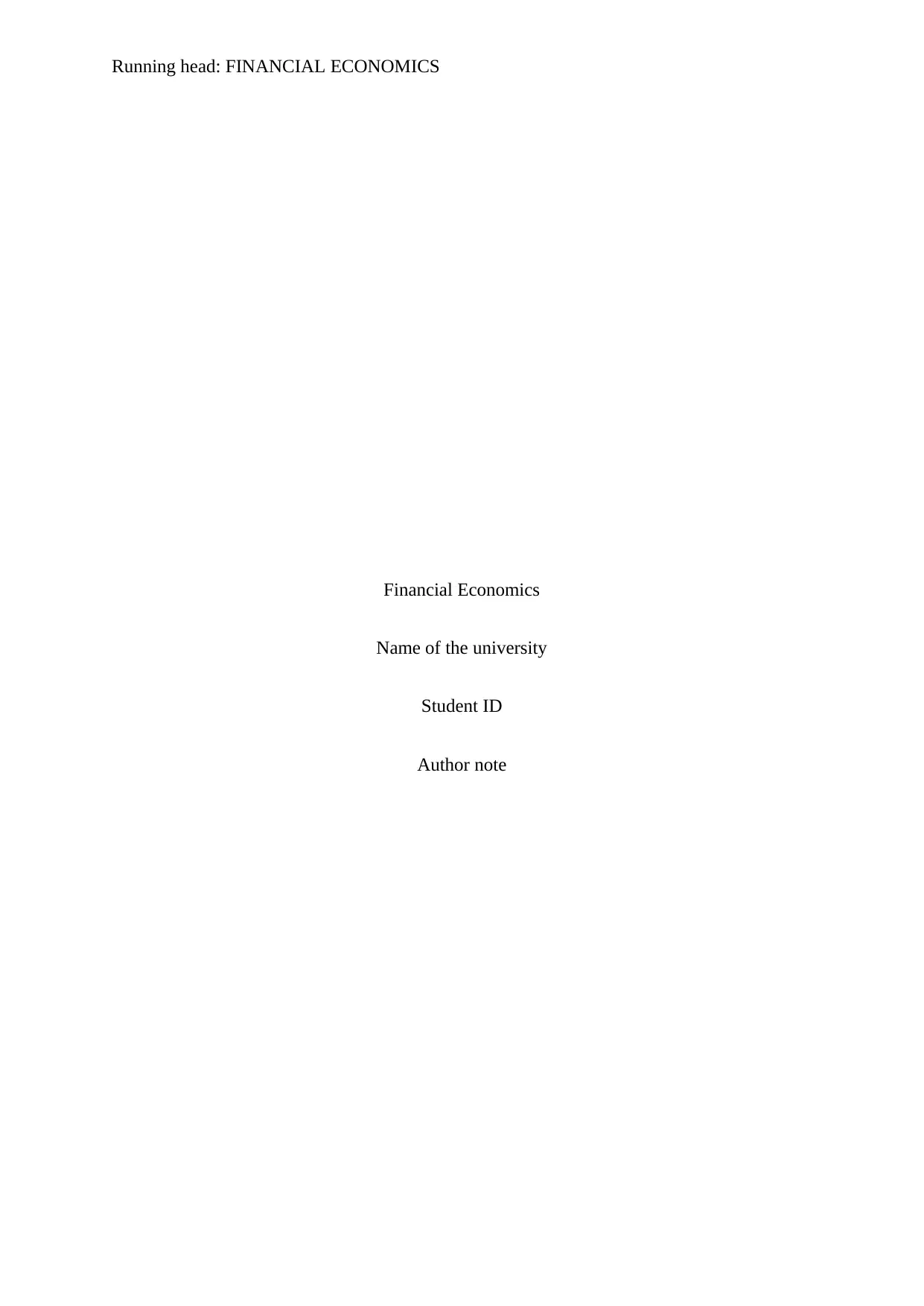
Running head: FINANCIAL ECONOMICS
Financial Economics
Name of the university
Student ID
Author note
Financial Economics
Name of the university
Student ID
Author note
Paraphrase This Document
Need a fresh take? Get an instant paraphrase of this document with our AI Paraphraser
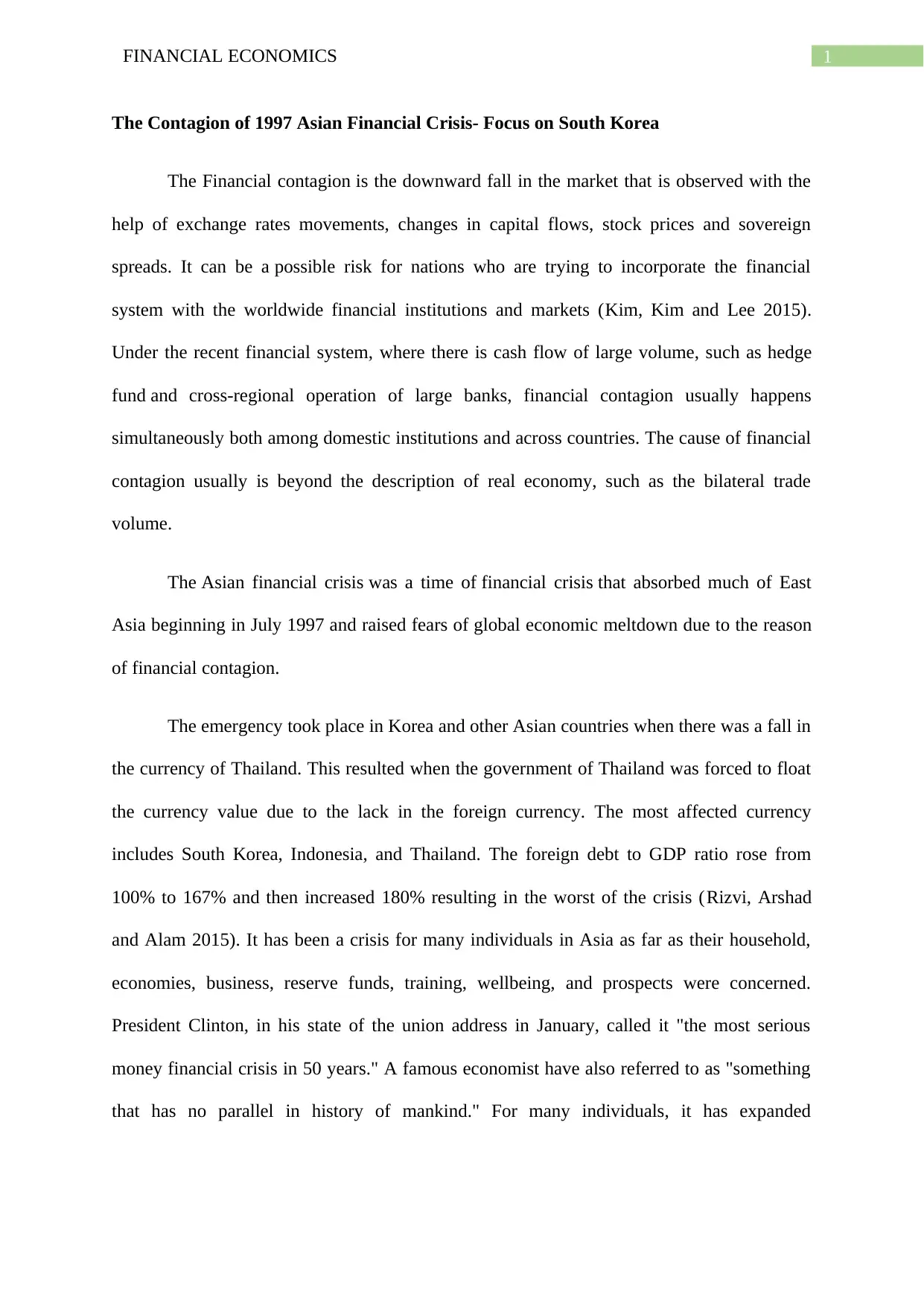
1FINANCIAL ECONOMICS
The Contagion of 1997 Asian Financial Crisis- Focus on South Korea
The Financial contagion is the downward fall in the market that is observed with the
help of exchange rates movements, changes in capital flows, stock prices and sovereign
spreads. It can be a possible risk for nations who are trying to incorporate the financial
system with the worldwide financial institutions and markets (Kim, Kim and Lee 2015).
Under the recent financial system, where there is cash flow of large volume, such as hedge
fund and cross-regional operation of large banks, financial contagion usually happens
simultaneously both among domestic institutions and across countries. The cause of financial
contagion usually is beyond the description of real economy, such as the bilateral trade
volume.
The Asian financial crisis was a time of financial crisis that absorbed much of East
Asia beginning in July 1997 and raised fears of global economic meltdown due to the reason
of financial contagion.
The emergency took place in Korea and other Asian countries when there was a fall in
the currency of Thailand. This resulted when the government of Thailand was forced to float
the currency value due to the lack in the foreign currency. The most affected currency
includes South Korea, Indonesia, and Thailand. The foreign debt to GDP ratio rose from
100% to 167% and then increased 180% resulting in the worst of the crisis (Rizvi, Arshad
and Alam 2015). It has been a crisis for many individuals in Asia as far as their household,
economies, business, reserve funds, training, wellbeing, and prospects were concerned.
President Clinton, in his state of the union address in January, called it "the most serious
money financial crisis in 50 years." A famous economist have also referred to as "something
that has no parallel in history of mankind." For many individuals, it has expanded
The Contagion of 1997 Asian Financial Crisis- Focus on South Korea
The Financial contagion is the downward fall in the market that is observed with the
help of exchange rates movements, changes in capital flows, stock prices and sovereign
spreads. It can be a possible risk for nations who are trying to incorporate the financial
system with the worldwide financial institutions and markets (Kim, Kim and Lee 2015).
Under the recent financial system, where there is cash flow of large volume, such as hedge
fund and cross-regional operation of large banks, financial contagion usually happens
simultaneously both among domestic institutions and across countries. The cause of financial
contagion usually is beyond the description of real economy, such as the bilateral trade
volume.
The Asian financial crisis was a time of financial crisis that absorbed much of East
Asia beginning in July 1997 and raised fears of global economic meltdown due to the reason
of financial contagion.
The emergency took place in Korea and other Asian countries when there was a fall in
the currency of Thailand. This resulted when the government of Thailand was forced to float
the currency value due to the lack in the foreign currency. The most affected currency
includes South Korea, Indonesia, and Thailand. The foreign debt to GDP ratio rose from
100% to 167% and then increased 180% resulting in the worst of the crisis (Rizvi, Arshad
and Alam 2015). It has been a crisis for many individuals in Asia as far as their household,
economies, business, reserve funds, training, wellbeing, and prospects were concerned.
President Clinton, in his state of the union address in January, called it "the most serious
money financial crisis in 50 years." A famous economist have also referred to as "something
that has no parallel in history of mankind." For many individuals, it has expanded
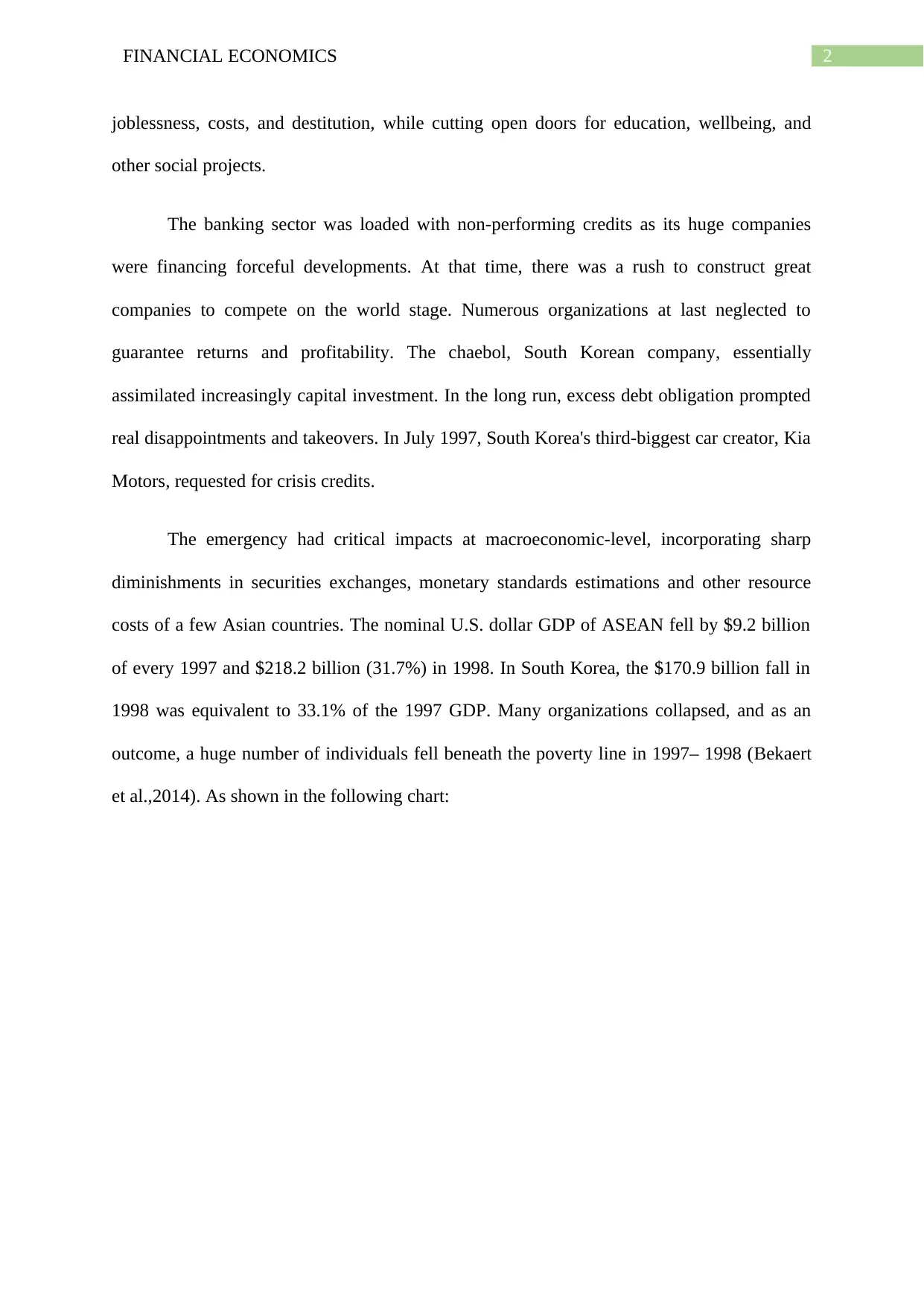
2FINANCIAL ECONOMICS
joblessness, costs, and destitution, while cutting open doors for education, wellbeing, and
other social projects.
The banking sector was loaded with non-performing credits as its huge companies
were financing forceful developments. At that time, there was a rush to construct great
companies to compete on the world stage. Numerous organizations at last neglected to
guarantee returns and profitability. The chaebol, South Korean company, essentially
assimilated increasingly capital investment. In the long run, excess debt obligation prompted
real disappointments and takeovers. In July 1997, South Korea's third-biggest car creator, Kia
Motors, requested for crisis credits.
The emergency had critical impacts at macroeconomic-level, incorporating sharp
diminishments in securities exchanges, monetary standards estimations and other resource
costs of a few Asian countries. The nominal U.S. dollar GDP of ASEAN fell by $9.2 billion
of every 1997 and $218.2 billion (31.7%) in 1998. In South Korea, the $170.9 billion fall in
1998 was equivalent to 33.1% of the 1997 GDP. Many organizations collapsed, and as an
outcome, a huge number of individuals fell beneath the poverty line in 1997– 1998 (Bekaert
et al.,2014). As shown in the following chart:
joblessness, costs, and destitution, while cutting open doors for education, wellbeing, and
other social projects.
The banking sector was loaded with non-performing credits as its huge companies
were financing forceful developments. At that time, there was a rush to construct great
companies to compete on the world stage. Numerous organizations at last neglected to
guarantee returns and profitability. The chaebol, South Korean company, essentially
assimilated increasingly capital investment. In the long run, excess debt obligation prompted
real disappointments and takeovers. In July 1997, South Korea's third-biggest car creator, Kia
Motors, requested for crisis credits.
The emergency had critical impacts at macroeconomic-level, incorporating sharp
diminishments in securities exchanges, monetary standards estimations and other resource
costs of a few Asian countries. The nominal U.S. dollar GDP of ASEAN fell by $9.2 billion
of every 1997 and $218.2 billion (31.7%) in 1998. In South Korea, the $170.9 billion fall in
1998 was equivalent to 33.1% of the 1997 GDP. Many organizations collapsed, and as an
outcome, a huge number of individuals fell beneath the poverty line in 1997– 1998 (Bekaert
et al.,2014). As shown in the following chart:
⊘ This is a preview!⊘
Do you want full access?
Subscribe today to unlock all pages.

Trusted by 1+ million students worldwide
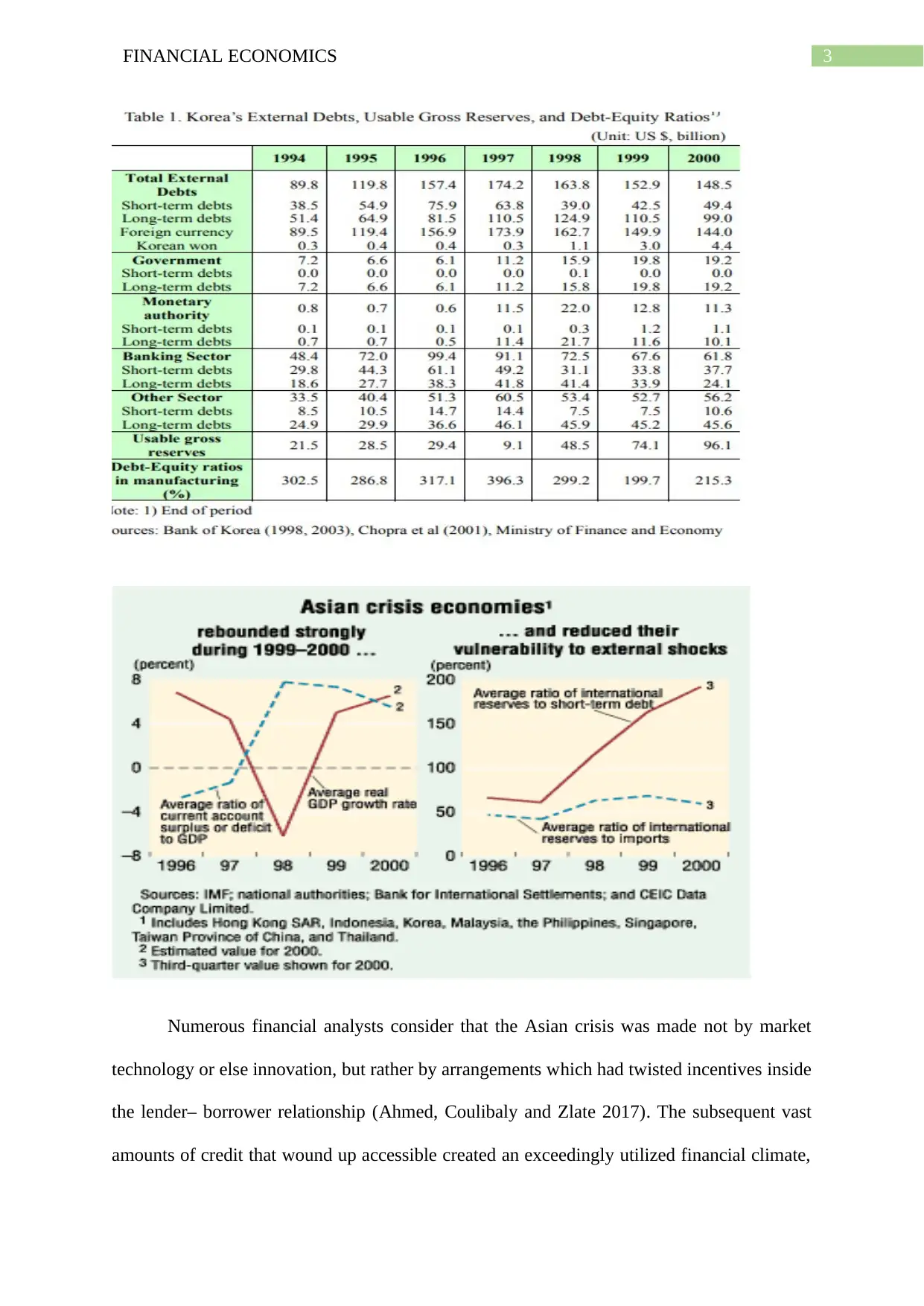
3FINANCIAL ECONOMICS
Numerous financial analysts consider that the Asian crisis was made not by market
technology or else innovation, but rather by arrangements which had twisted incentives inside
the lender– borrower relationship (Ahmed, Coulibaly and Zlate 2017). The subsequent vast
amounts of credit that wound up accessible created an exceedingly utilized financial climate,
Numerous financial analysts consider that the Asian crisis was made not by market
technology or else innovation, but rather by arrangements which had twisted incentives inside
the lender– borrower relationship (Ahmed, Coulibaly and Zlate 2017). The subsequent vast
amounts of credit that wound up accessible created an exceedingly utilized financial climate,
Paraphrase This Document
Need a fresh take? Get an instant paraphrase of this document with our AI Paraphraser

4FINANCIAL ECONOMICS
and pushed up resource costs to a level that is unsustainable. These benefit costs in the end
started to collapse, making people and organizations default on debt obligation.
and pushed up resource costs to a level that is unsustainable. These benefit costs in the end
started to collapse, making people and organizations default on debt obligation.
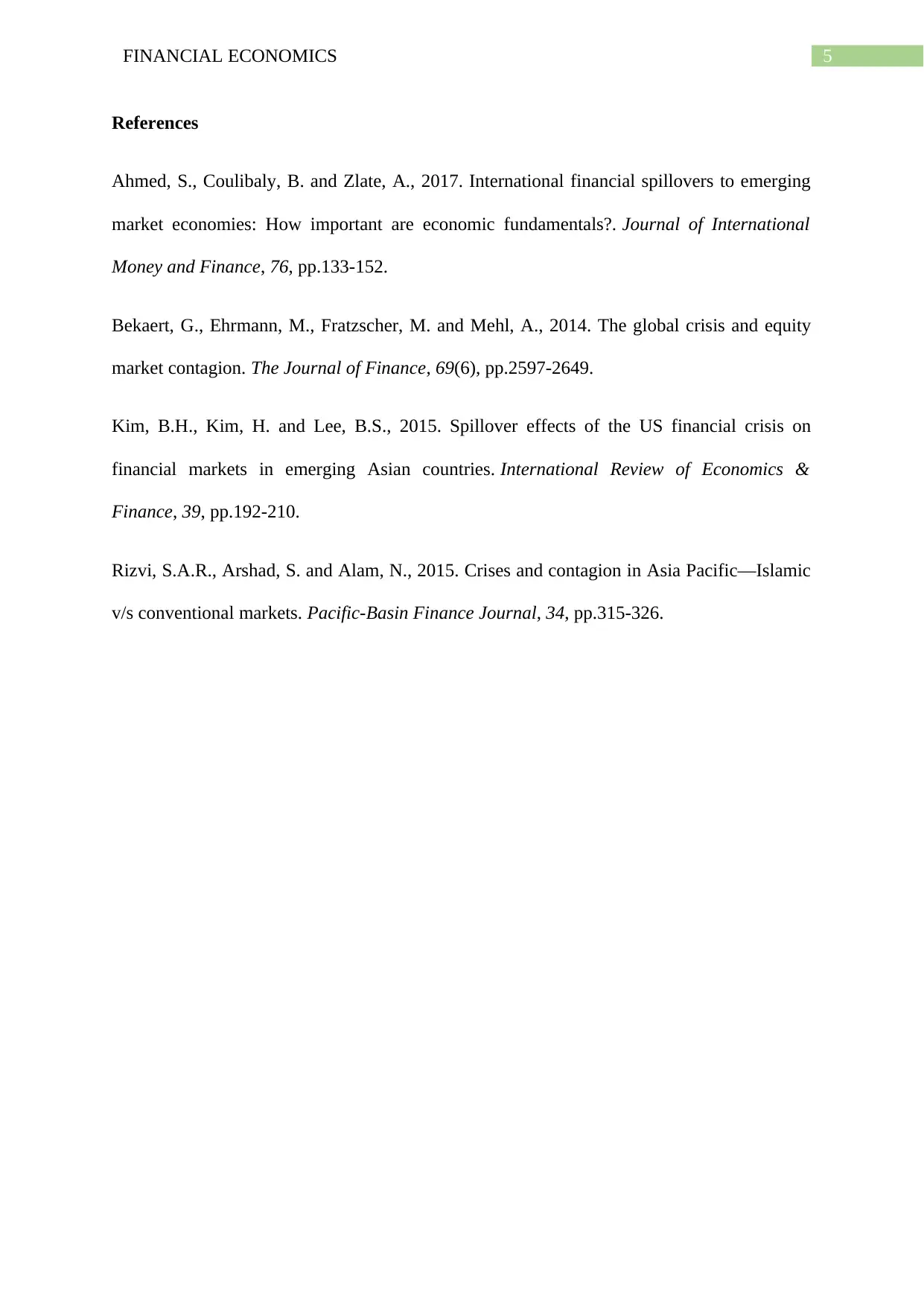
5FINANCIAL ECONOMICS
References
Ahmed, S., Coulibaly, B. and Zlate, A., 2017. International financial spillovers to emerging
market economies: How important are economic fundamentals?. Journal of International
Money and Finance, 76, pp.133-152.
Bekaert, G., Ehrmann, M., Fratzscher, M. and Mehl, A., 2014. The global crisis and equity
market contagion. The Journal of Finance, 69(6), pp.2597-2649.
Kim, B.H., Kim, H. and Lee, B.S., 2015. Spillover effects of the US financial crisis on
financial markets in emerging Asian countries. International Review of Economics &
Finance, 39, pp.192-210.
Rizvi, S.A.R., Arshad, S. and Alam, N., 2015. Crises and contagion in Asia Pacific—Islamic
v/s conventional markets. Pacific-Basin Finance Journal, 34, pp.315-326.
References
Ahmed, S., Coulibaly, B. and Zlate, A., 2017. International financial spillovers to emerging
market economies: How important are economic fundamentals?. Journal of International
Money and Finance, 76, pp.133-152.
Bekaert, G., Ehrmann, M., Fratzscher, M. and Mehl, A., 2014. The global crisis and equity
market contagion. The Journal of Finance, 69(6), pp.2597-2649.
Kim, B.H., Kim, H. and Lee, B.S., 2015. Spillover effects of the US financial crisis on
financial markets in emerging Asian countries. International Review of Economics &
Finance, 39, pp.192-210.
Rizvi, S.A.R., Arshad, S. and Alam, N., 2015. Crises and contagion in Asia Pacific—Islamic
v/s conventional markets. Pacific-Basin Finance Journal, 34, pp.315-326.
⊘ This is a preview!⊘
Do you want full access?
Subscribe today to unlock all pages.

Trusted by 1+ million students worldwide
1 out of 6
Related Documents
Your All-in-One AI-Powered Toolkit for Academic Success.
+13062052269
info@desklib.com
Available 24*7 on WhatsApp / Email
![[object Object]](/_next/static/media/star-bottom.7253800d.svg)
Unlock your academic potential
Copyright © 2020–2025 A2Z Services. All Rights Reserved. Developed and managed by ZUCOL.





